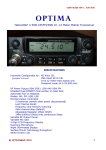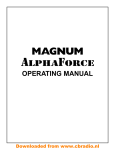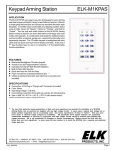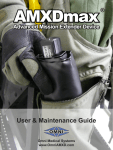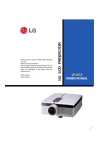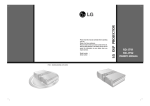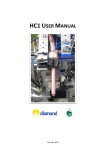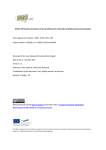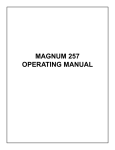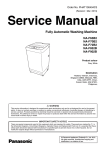Download Yeticomnz Optima MK2 User guide
Transcript
OPTIMA MK2 OWNERS MANUAL & USER GUIDE Downloaded from www.cbradio.nl 24.500 – 29.999 Mhz 50W All Mode HF Mobile Transceiver (February 2012 production) REV 1.61 Copyright © January 2012 by YeticomNZ. All rights reserved. TABLE OF CONTENTS Introduction ......................................................................................................... 3 Notification of new functionality.............................................................................3 Limited Warranty.................................................................................................. 4 Installation ...................................................................................................... 5 - 6 Microphone Wiring........................................................................................5, 6, 7 Mode Information (Jumper Settings).................................................................6, 9 Front Panel Controls .................................................................................... ...7- 9 Step Function........................................................................................................7 Split Frequency Operation....................................................................................8 Memory Function..................................................................................................8 Other Features .................................................................................................... 9 Specifications .....................................................................................................10 User Information..................................................................................................11 Contact Information ........................................................................................... 12 2 INTRODUCTION Congratulations on your purchase of Yeticom's OPTIMA 10/12 meter SSB/AM/FM transceiver. The OPTIMA is designed to provide years of enjoyment and trouble-free service. There are many features and functions designed into this transceiver. To ensure that your investment is enjoyed to its fullest extent, please take a few moments and thoroughly read this manual. The OPTIMA is a 50w all mode microprocessor controlled, user programmable radio combining high RF performance with a user-friendly environment. The OPTIMA is a 12 volt DC, HF transceiver designed for mobile use. The transceiver utilizes the latest in surface mount production techniques. This keeps the size of the unit to a minimum without sacrificing any of the advanced circuits required for today’s high performance radios, and as cabin space diminishes in modern vehicles, this concept helps create a wider variety of installation options. Although engineered with mobile use in mind the OPTIMA, with the addition of a high quality 10-amp power supply, may be easily adapted for fixed station operation. Some of the features of the OPTIMA are; an advanced design liquid crystal display that provides the operator with a full visual account of the transceivers operating status, automatic frequency or memory scanning, memory storage of your favorite frequencies and modes, programmable frequency resolution of either 1 kHz, 5khz, 10 kHz, 100 kHz and 1mhz, and split frequency operation for repeater use. The default frequency step is 5khz and the radio includes full coverage the new 12m Amateur band. A small fan has been added to the heat sink to ensure cool operation in warmer climates. A second filter has been added to the IF chain and this can be switched in or out from the front panel as required. The 8 pin microphone plug is compatible with most icom microphones and base microphones can be easily rewired to suit the OPTIMA. These are just a few of the features that make the OPTIMA a pleasure to own and operate. IMPORTANT: The OPTIMA is designed for amateur radio use. In many countries a licensed amateur radio operator must be present at the station. Please make sure you comply with the licencing regulations in place for the country you are operating in. NOTICE: The following paragraph outlines the changes made to the radio for the February 2012 production. 1. Step Function. The step function default is 5khz. The radio will default to 5khz when the radio is powered on. On previous models the radio would only hold the step function chosen until another function was engaged (ie press the PTT) upon which the radio would revert to 5khz step function. From the 2012 MK2 release onwards the step function chosen by the step button 1, will remain until either changed by the step function or the radios is powered off, when the step will revert to 5khz. The choice of 1khz, 5khz, 10khz, and 100khz is retained. 2. Mic Gain. The mic gain circuits have been increased a further 10db for 2012 to allow for stronger FM audio and allow greater control of user supplied microphones. In SSB the best audio with supplied microphone will be about 50% or 12 O'clock. More may cause overmodulation and a decrease in SSB audio quality. 3. Function Switch. The function switch has been removed from the clarifier and is now located on VFO frequency selector control. This is to allow users to activate the function control without disturbing the clarifier position. Depress VFO knob to activate FUNCTION 3 LIMITED WARRANTY YeticomNZ warrants this product to be free of defects for a period of one (1) year from the original date of purchase. This warranty is non-transferable. This limited warranty is subject to repair or replacement of defective components only. This warranty is void if the radio has been tampered with or misused. In the event of a malfunction the radio should be returned to the factory for examination and repair. This allows us to maintain the quality of the product and become aquainted with any problems occurring in the field and to effect changes in future production if required. Freight to factory will be paid by owner while the fault is assesed. Should the fault be deemed to be caused by operator abuse or misuse then the repair and freight costs will be charged to the customer. If the fault is caused by product or component failure the cost of shipping and repair will be borne by the company within the one year period as stipulated above. This factory repair warranty applies to radios purchased though YeticomNZ but may also be valid for other sellers on discussion with the factory. Contact [email protected] re warranty issues. Spare parts may also be purchased as required. Additional microphones, power cords, spare knobs etc. Please be careful of the microphone plug layout when configuring user supplied microphones as there are live voltages supplied to run electret type microphone elements that should not be used on dynamic microphones. (Pin 2 +8V DC) The driver and PA final transistors are IRF 520 MOSFET devices. (3 ea) Serial Number. The serial number is found on the rear of the radio on the outside of the heatsink connected to the fan. IMPORTANT: RETAIN YOUR SALES RECEIPT/PROOF OF PAYMENT 4 INSTALLATION 1. Contents Unpack and inspect your OPTIMA for missing or damaged components. Your OPTIMA includes the following items: Quantity 1 1 1 1 1 Description YeticomNZ OPTIMA Transceiver Microphone with Up/Down Controls Mounting Bracket with Hardware Microphone Hanger with Hardware Set Operating Manual and DC power cord 2. Microphone Hanger The microphone hanger may be attached to the side of the transceiver, or any other convenient location. Use the provided screws to attach the microphone hanger either vertically or horizontally to the side of the transceiver. 3. Mounting When attaching the OPTIMA mounting bracket to the vehicle, choose a location that will provide easy access to all front panel controls and air circulation to the rear panel. When selecting a mounting location, make sure that there is ample space behind the control deck for the cables. Do not pinch, or bend sharply, the power or antenna cables. Do not install the OPTIMA in any compartment that restricts airflow and do not install in a location that interferes with the safe operation of the vehicle. Attach the mounting bracket to the vehicle first then mount the OPTIMA to the bracket. If the rear panel is not accessible you may want to attach the power and antenna cable prior to mounting. 4. Electrical Connections The OPTIMA is designed to work on any 13.8 volt DC, negative ground, source. The condition of a vehicle’s electrical system can affect operation. A low battery, worn generator/alternator, or poor voltage regulator will seriously impair the performance of the transceiver. Any of the above conditions could result in a high level of receiver noise generation or a substantial loss of the transmitter’s RF output. Make sure that all of these components of your vehicle’s electrical system are in good condition prior to installing the transceiver. CAUTION! VOLTAGE EXCEEDING 15 VDC WILL DAMAGE THE RADIO. MEASURE VOLTAGE AT BATTERY TERMINALS, WITH VEHICLE RUNNING, PRIOR TO INSTALLATION! Before making any electrical connections make sure the AF gain (volume) control on the control deck is in the “OFF” position. Connect the positive (+) red wire of the DC power cord to a positive 13.8 volt source at the vehicle fuse block. If connecting to the fuse block, it is recommended that a switched power source is used so that the power to the transceiver is disconnected when the vehicle is off. This will eliminate the possibility of the transceiver draining the vehicle’s battery. Fuse 12A slow blow type Connect the negative (-) black wire to a metal part of the vehicle’s frame, or chassis ground. Make sure that this is a good ground connection. The OPTIMA power cord may also be connected directly to the battery. Connecting directly to the battery has several benefits, the first of which is to maximize RF output. Secondly, the battery is a very large capacitor and will help eliminate certain types of ambient and vehicle noise. If connecting directly to the vehicle’s battery, additional power cable may be required. On runs of 8 feet or less use 12-gauge stranded wire. Use 10-gauge wire on longer runs. 5. Antenna Connection The transceiver will operate using any standard 50ohm ground-plane, vertical, mobile whip, long wire or similar antenna. The antenna should be rated at 50 watts PEP minimum. A standard SO-239 type antenna connector is located on the rear panel of the OPTIMA. Connection is made using a PL-259 and high grade coaxial cable (RG213, RG58A/U or Mini RG-8 is recommended). A ground-plane antenna provides greater coverage and is recommended for fixed station-to-mobile operation. For point-to-point fixed station operation, a directional beam antenna operates at greater distances even under adverse conditions. A non-directional antenna should be used in a mobile installation; a vertical whip is best suited for this purpose. The base loaded whip antenna normally provides effective communications. For greater range and more reliable operation, a full quarter wave whip may be used. Either of these antennas uses the metal vehicle body as a ground plane. Once the antenna is mounted on the vehicle, route the coaxial cable so that it is not next to any power cables or vehicle cables. Connect the PL-259 to the antenna connector on the rear panel of the OPTIMA. Make sure that the cables does not interfere with the safe operation of the vehicle. Microphone Connections Pin 1 Pin 2 Pin 3 Pin 4 5 Mic Input, +8VDC Freq up/dn NC Pin 5 Pin 6 Pin 7 Pin 8 PTT Ground (PTT) Ground (MIC) NC 6. VSWR Before use, it is important to determine the antenna system’s VSWR (voltage standing wave ratio). First, make sure the SWR bridge (meter) is in good working order and is calibrated. To ensure your radio is performing properly the VSWR should never exceed 1.5 to 1. Never transmit on any antenna system where the VSWR exceeds 1.8 to 1. This will stress the output stage and could destroy the RF transistors; this type of misuse and failure is not covered under warranty.Measure the VSWR at the center of the operating band. Tune the antenna (according to the manufacturer’s tuning instructions) so that the VSWR is as close to 1.1 to 1 at the center of the operating band. Next, measure the VSWR at the lowest and highest frequency of the transceiver. If the antenna has a wide enough frequency range and band-pass, the VSWR readings should be below 1.5 to 1 across the entire operating band. If at the lower or upper end of the transceiver operating frequency, the VSWR measures more than 1.5 to 1, it is recommended that the antenna be re-tuned before operating on those frequencies. If you are experiencing unusual VSWR readings check for the following possible problems: 1) Make sure that the antenna is installed properly and grounded. 2) Check all coaxial cable and connectors for defects and poor routing. 3) If testing a vehicle installation, make sure that all vehicle doors are closed when testing. 4) Do not test near or around large metal objects or buildings. 7. Ignition Noise In certain vehicle installations, electrical noise or interference may be present in the receive audio of the transceiver. Typically the vehicle’s ignition system or more specifically the alternator generates this noise. The OPTIMA is equipped with a noise blanker circuit that is designed to improve, and in many instances eliminate, this electrical noise. In extreme cases, the noise blanker may not eliminate all the electrical noise. In such cases, an after-market alternator noise or ignition noise filter can be purchased and installed according to the manufacturer’s instructions. If purchasing an alternator noise filter for the OPTIMA make sure the filter is rated for at least 15 amps continuous current draw. Using With a Power Supply. Do not place the Optima radio on top of the power supply. Maintain a distance of 50cm between the power supply and the radio where possible. The Optima is designed to be used with an input voltage of 13.8v. Using with an Amplifier. The optima is not fitted with a PTT output to key an external amplifier. The output of the Optima can be used with any amplifier capable of accepting a 50w PEP input. The power control may be reduced to suit other types of amplifiers. Be careful when using with dual transistor CB amplifiers as the full output from the Optima can cause these amplifiers to distort due to overdriven condition. Use a class AB amplifer on SSB and make sure the output is suitably filtered to reduce harmonics. Remember that most distortion and amplifier failures are caused by overdriving the amplifier. Hi SWR and overheating are the next causes. Keep your amplifier cool and have an SWR meter in line between the amplifier and the antenna to observe the output of the amplifier and SWR of the antenna at all times. Try to maintain 50cm distance between the amplifier and the radio to reduce RF feedback. Ground the amplifier where possible, especially in mobile installations. MODE Information. (configured via Internal jumpers) The jumpers (4) are found on the main board behind the 8 pin microphone socket. Only one jumper should be engaged at a time. Ham Mode 24.5 to 24.999mhz & 28.0 to 29.999mhz Toggle between 12m and 10m by use of the call button. NZ CB Mode 26.330 to 26.770mhz. Covers the NZ 40ch CB band in 10khz steps and optional channel readout. Func and call to toggle between channel and frequency. Shift function is not available. USA/AUS 40ch CB Mode Covers the USA 40ch CB band in 10khz steps and optional channel readout. Func and call to toggle between channel and frequency. Shift function is not available. Freeband Mode Radios are usually shipped in this mode. All functions and 24.5 to 29.9mhz continuous coverage. No jumpers. Jumpers on main board behind microphone socket 6 FRONT PANEL CONTROLS 1. MICROPHONE INPUT An 8-pin, lock ring type, mic connector is used. 4. STEP \ NB \ 1 STEP: Tuning Step. The STEP control selects frequency resolution in either 1 kHz, 10 kHz or 100 kHz steps. Press the STEP button, one of the digits will flash on and off. Press the STEP button again to change stepping resolution. 8 pin Mic Socket To tune frequencies in either 10 kHz or 100 kHz increments, press the STEP button until the desired digit is flashing. Rotate the VFO control in either direction. The entire frequency range of the OPTIMA can be stepped through in 1, 5, 10 or 100 kHz increments. 2. MICROPHONE GAIN CONTROL Increases or decreases the energy developed in the microphone amplifier circuit. The gain increases as the control is rotated clockwise. For optimum setting, press the push-to-talk (PTT) switch on the microphone, adjust the mic gain control until all segments of the S/RF display are lit. Next, rotate the control counterclockwise until the last segment of the display starts to flicker. The S/RF display is the bar graph located on the lower edge of the LCD screen. To tune in 1 kHz increments, press the STEP button until the 1 kHz digit flashes on and off. Rotate the VFO control clockwize or anticlockwize to scroll. NOTE: When stepping in 1 kHz increments, you are NOT limited to tuning within a 10 kHz frequency range. 3. RF GAIN CONTROL Adjusts the receiver sensitivity to both signals and background noise. This affects the distance at which a signal can be detected. Turning the control counterclockwise reduces the receiver sensitivity. This is particularly useful in areas where large volumes of traffic (signals) are present. The S/RF display indicates the received signal’s strength. The S/RF display is the bar graph located on the lower edge of the LCD screen. NOTE: The RF Gain may need to be reduced under certain conditions. The optima has a very sensitive receiver with a 3-6db increase in sensitivity over previous models. Under certain conditions the active AGC can cause the received audio to distort and this should be corrected by reducing the RF gain which will cause the noise to reduce and the signal to be readable once more. The Default Step function is 5khz on the OPTIMA IMPORTANT! Operating some of the features in 4 through 9 require the use of the FUNCTION control. To activate the function control, momentarily push the VFO knob inwards, the FUNC prompt will be displayed in upper left-hand corner of LCD. Push the control again briefly to deactivate the function control. Memory Scan To activate the Memory Scan, press the FUNC control (VFO) and then press the M-SCAN button. The radio will now commence scanning just the memory channels. NB: Noise Blanker. Noise blanker on and off control. This circuit eliminates pulse type interference usually associated with automotive ignition systems. To activate the noise blanker, press the FUNC control and then press the NB button. NB will appear on the LCD indicating the noise blanker is turned on. To turn off the noise blanker, repeat the same process. 1: Memory Channel 1. After programming this button is memory channel 1. See M.LOAD \ M.SAVE control for programming instructions. 5. LCR \ M-Scan \ 4 LCR: Last Channel Recall. Press the LCR button to return to the last frequency that was transmitted on for more than 3 seconds. Memory Channel 4. After programming this button is memory channel 4. See M-RECAL \ M.SAVE control for programming instructions. Buttons pictured in orange on a black background indicate VFO must be engaged to access. Buttons pictured in White on black background can just be pressed to access. 7 6. MHZ / CALL \ 2 MHZ: Depressing the MHZ button will advance the Frequency by 1mhz each time. The CALL button has no function in this model Optima. CB Modes: With the FUNC actve the display will toggle between channel read out and frequency read out. In Ham Mode: The radio will toggle between 10m and 12m modes. In freeband mode the OPTIMA will step up in 1mhz steps. 2: Memory Channel 2. After programming this button is memory channel 2. See M-RECAL \ M.SAVE for programming instructions. 7. MODE \ T. LOW \ 5 MODE: Operating Mode. Press the MODE control to select the operating mode. The operating mode is indicated on the liquid crystal display: AM, FM, USB, or LSB. T. LOW: Tone Low. Press the FUNC button, and then press the T. LOW button to turn on the receive audio tone control. LOW will appear on the LCD when the low tone is activated. This feature will roll-off high frequency noise (i.e. “white” noise). Under many operating conditions this will improve the clarity and understanding of received signals. 5: Memory Channel 5. After programming this button is memory channel 5. See M-RECAL \ M.SAVE control for programming instructions. 8. SCAN \ SHIFT \ 3 SCAN: Frequency Scan. Scans in increments of 5 kHz. There are two ways to scan using the front panel controls. (1) Receive Audio On Scanning: Press the SCAN button. Scan rate is one step every 5 seconds. To stop scanning press the SCAN button again, or momentarily press the PTT button on the microphone (scanning will stop without transmitting). (2) Receive Audio Mute Scanning: Carefully rotate the squelch control a minimum excursion (refer to 14) until the receive audio is off. The receiver scan rate will now be five frequencies per second. When a signal is detected the squelch is automatically disengaged and the scanning is paused. The squelch circuit will automatically re-engage and the receiver will continue to scan the moment the received signal is no longer detected. To stop scanning, press the SCAN button, or momentarily press the PTT button on the microphone (scanning will stop without transmitting). SHIFT: Shift Offset. Used for programming offsets to operate repeater networks. The OPTIMA can transmit and receive on different frequencies. The shift default is 000khz so the offset required will need to be set by the user first. To program the offset, press the FUNC control (VFO) and hold down the SHIFT button for 2 or 3 seconds. Three digits will appear on the LCD screen. This is the offset frequency in kHz. Rotate the VFO control until the desired offset frequency is displayed. The shift can be set in increments of 5khz only from 5khz to 995khz. To return to the main display press the FUNC control and hold down the SHIFT button for 3 or more seconds, or momentarily press the PTT button on the microphone (the transmitter will not be engaged). To activate the programmed offset frequency, press the FUNC control, and then press the SHIFT button once. +SHIFT is displayed on the LCD. The radio will now transmit on the frequency that is XXX kHz greater than the displayed, or receive, frequency (XXX represents the programmed offset frequency in kHz). To transmit on the frequency that is XXX kHz lower than the displayed, or receive, frequency press FUNC, then the SHIFT button. Repeat this until -SHIFT is displayed on the LCD. To disengage the programmed offset frequency, press the FUNC control and then press the SHIFT button. Repeat this until the SHIFT indicator is no longer displayed on the LCD. 3: Memory Channel 3. After programming this button is memory channel 3. See M-RECAL \ M.SAVE control for programming instructions. 9. M.SAVE \ M-RECAL M.SAVE: Memory Save. To save in memory a specific frequency and operating mode, select the desired mode and rotate the VFO control to the desired frequency. Press the FUNC control (VFO) and then press the M.SAVE button. S will appear on the LCD next to the frequency. While S is displayed, immediately press any of the memory channel buttons (1 - 5). The mode and frequency is now saved into memory. If the S indicator disappears before you press the memory channel button, the information will not be saved and the process must be repeated. M-RECAL: Memory Recall. To load, or recall, any of the saved memory channels press the M-RECAL button. L will appear on the LCD for several seconds. While the letter is displayed press the desired memory channel button (1 - 5). The programmed mode and frequency will be displayed. (3) Memory Scanning: Press the FUNC control (VFO), and then press the M-SCAN (button 4) The radio will then scan those frequencies in memory pausing for 3 seconds each time. Scanning will not stop if frequency is in use. Using the squelch will cause the scanning only to pause on frequencies breaking the squelch. 8 10. CLAR \ FUNC CLAR: Clarifier. The clarifier shifts both the TX and RX frequency 1.0 kHz each side of the center frequency. This is necessary for tuning to an SSB signal. Rotate the clarifier control clockwise or counterclockwise to tune an SSB signal. FUNC: Function. This control is used to operate the six control buttons on the front panel that are printed in ORANGE. Press slightly and release, (do not hold) FUNC will be displayed on the LCD indicating that the function command is activated. After you have pressed one of the buttons the FUNC will disappear from the screen. 2. When pushed and held for 2 seconds the additional IF crystal filter will be engaged. This will help to reduce noise and interference from nearby stations in most instances. To disengage repeat the above. A small led to the left of the frequency selector will illuminate when the filter is active. OTHER FEATURES 1. PROGRAMMING TONE This tone sounds each time the CPU is being programmed. It is helpful, in the beginning so you can be sure the command has been entered. You may eliminate the tone by simply pressing the PTT switch on the microphone and turning on the ON/OFF POWER switch at the same time. 2. Memory Back Up The memories in the OPTIMA are stored in non Volatile RAM and will remain until user changed, despite the radio being disconnected from the power source for long periods of time 3. Internal Jumpers to set Operating Mode The Optima has a small jumper board inside the radio to allow users to set the mode of operation. Currently these modes are: 1. 2. 3. 11.VFO Selector: Rotate clockwise or counterclockwise to select the desired frequency. Rate of change is selected by depressing the STEP button 12. OFF / VOLUME OFF: Turns the power to the radio on and off. VOLUME: Adjusts the AF gain, or volume of the received audio. Turn clockwise to increase and counterclockwise to decrease. 14. SQ: Squelch. Used to eliminate background or “white” noise when monitoring strong signals. Also used to activate SCAN feature (refer to 8). To properly adjust squelch circuit, start rotating the control slowly clockwise until the received white noise disappears. 15. PWR: Variable RF Output Power. Rotate clockwise to increase RF output power. Rotate counterclockwise to decrease RF output power. Variable RF output power allows low power for QRP operation. 4. NZ 40 CB Channels only. (Optional Ch. Readout) US 40 CB Channels only (Optional Ch Readout) 10 & 12m ham Bands Only (24.5mhz- 24.9mhz & 28.0mhz to 29.999mhz) Free Band (24.5 - 29.999mhz) Reset. The internal processor can be reset by turning on the radio with the Function (VFO) depressed. Radio returns to default condition. Deletes all memories and offsets. External Fan External Fan on heatsink allows radio to run cooler at higher powers. It is controlled from the PTT and runs for 30 seconds after PTT is released. Additional IF Filter The 2nd IF Filter is now incorporated into the under side of the circuit board. Press and hold the VFO control for 3 seconds to activate. The Filter light will illuminate. Press again VFO knob in again for 3 seconds to deactivate. There is some loss of received audio volume that can be corrected by increasing the volume. Offending signals 10khz away can be reduced by over 20db and about 6db for signals 5khz away. The effect will change slightly depending on the sideband in use. 16. Push-To-Talk Switch: Press and hold the switch to transmit. TX will appear on the LCD screen when transmitting. Release the switch to receive. Rear Fan on Heat Sink 17. UP / DN on microphone: Up and Down Frequency Controls. Press the UP control to increase in frequency. Press the DN control to decrease in frequency. REAR PANEL 1. External Speaker Jack An external speaker jack is located on the rear panel of the transceiver. The OPTIMA is designed to accept any standard 8 ohm external speaker for use with twoway transceivers. The fan will operate immediately the radio goes into transmit mode and will remain on for 30 seconds after the PTT is released to cool the heat sink and the associated output power devices properly. The Mosfet PA devices used in the Optima will automatically decrease in power if they experience excessive heat build up. 9 OPTIMA GENERAL SPECIFICATIONS Frequency Coverage Antenna Impedance Frequency Control Frequency Accuracy Power Requirement Current Consumption Dimensions Weight Shipping weight : Transmit and Receive .................................. 24.500 to 29.999 MHz : 50 ohm, unbalanced : Digital Phase-Lock Loop (PLL) Synthesizer : Better than +10 ppm from 0 - 40 0C after 15 min. warm up : 12 - 13.8 V DC, negative ground : 8 amps maximum : 6 x 2 x 9.5 in (W x H x D) : 2.9 lbs : 2.050 Kg TRANSMITTER SPECIFICATIONS Power Output : SSB / FM............................................................................... 50 Watts PEP : AM ..........................................................12 Watts Average / 50 Watts PEP Tuning Steps : 1 kHz / 5khz / 10 kHz / 100 kHz (5khz default) Final Transistors : IRF520 MOSFET (x2) Spurious Emissions : More than 50 dB below peak output power Carrier Suppression : More than 40 dB below peak output power Unwanted Sideband : More than 50 dB below peak output (1 kHz tone) FM Deviation : +/- 2 kHz maximum Audio Response : More than 30dB below peak output Frequency Response : 400 to 2800 Hz Microphone Impedance : ECM, 600 to 1K ohms RECEIVER SPECIFICATIONS Circuit Type : Dual-Conversion Superheterodyne Intermediate Frequencies : 1st IF / SSB IF .................................................................. 10.695 MHz : 2nd IF ..................................................................................... 455 kHz Sensitivity : SSB............................................................. 0.23 μV at 10 dB S + N/N : AM ................................................................ 0.23 μV at 10 dB S + N/N : FM................................................................... 0.3 μV at 12 dB SINAD Selectivity : SSB................................................ 4.2 kHz (-6 dB) / 8.5 kHz (-60 dB) : AM / FM .......................................... 6.0 kHz (-6 dB) / 18 kHz (-60 dB) Clarifier Range : +/- 3.0 kHz Adjacent Channel Rejection IF Rejection Frequency Response Audio Output Power Audio Output Impedance : Better than 70 dB (with further improvement when 2 nd IF filter engaged) : Better than 80 dB for all frequencies : 250 to 3000 Hz : 2 watts minimum at 10% THD with an 8 ohm load : 8 ohms 10 User Information Date Of Purchase : Name of Buyer : Place of Purchase : Serial Number : 11 YETICOMNZ Hong Kong Singapore Jakarta New Zealand Providers of Specialized 10/12 meter HF radio products http://www.yeticomnz.com 12












